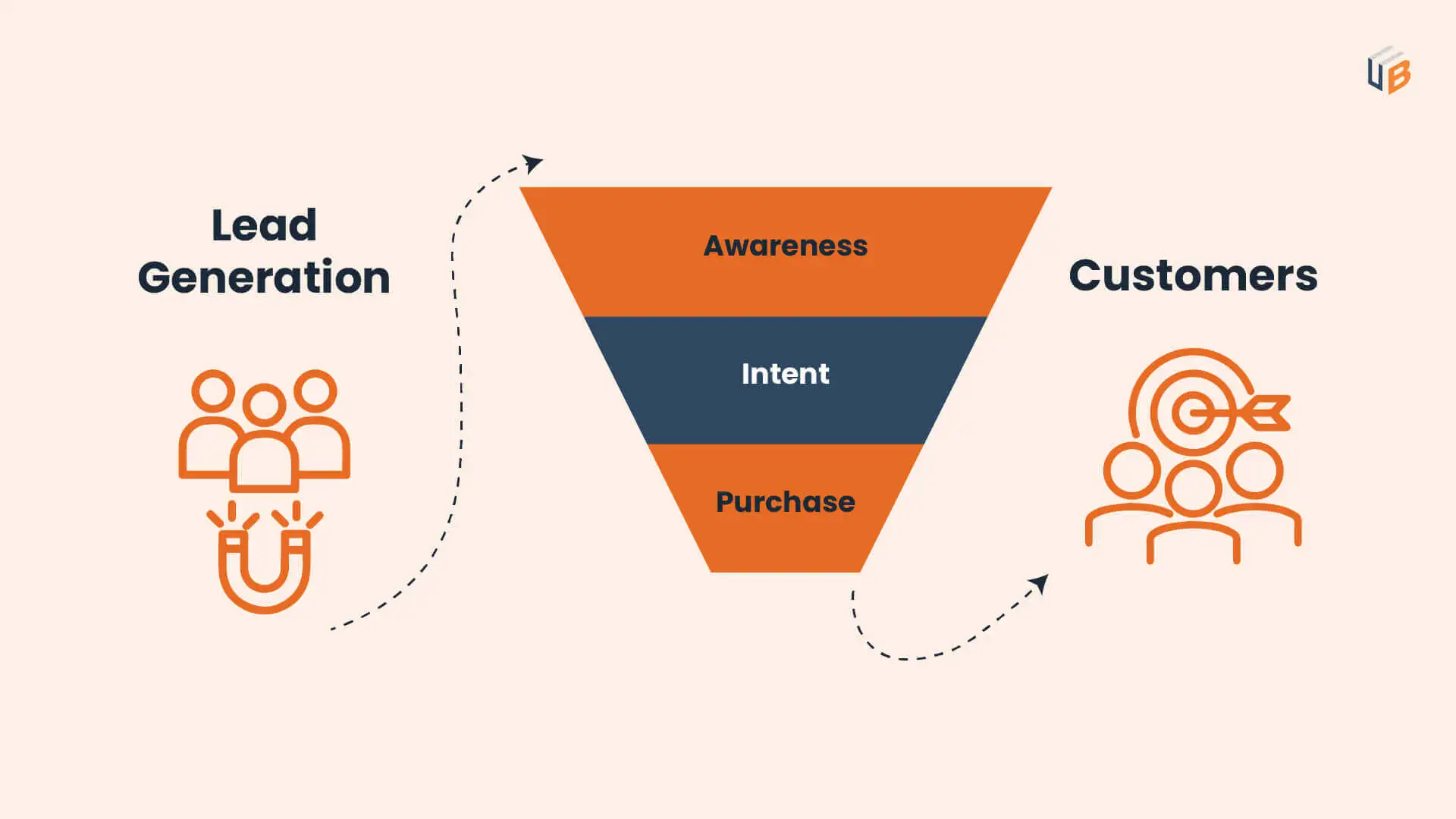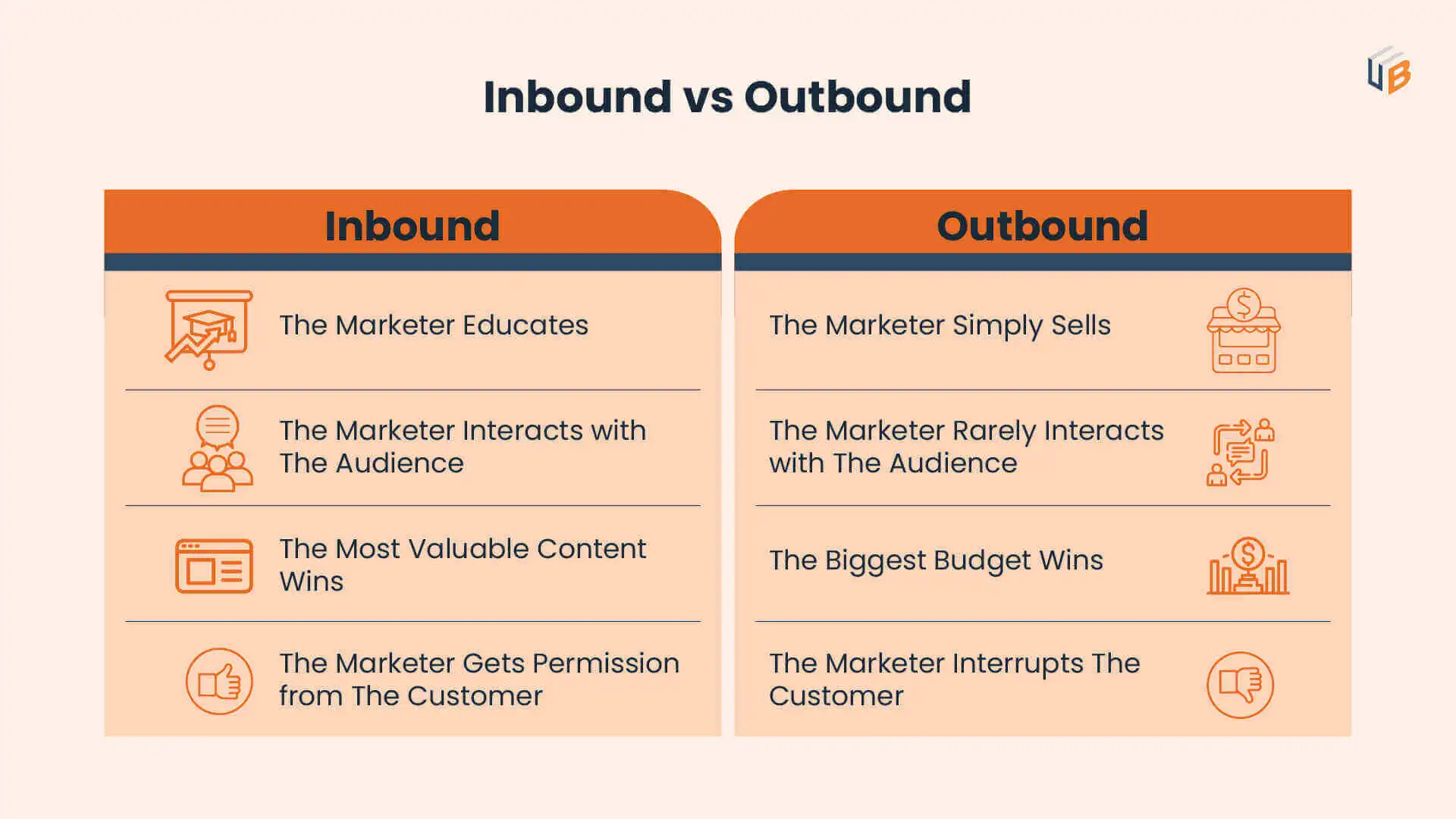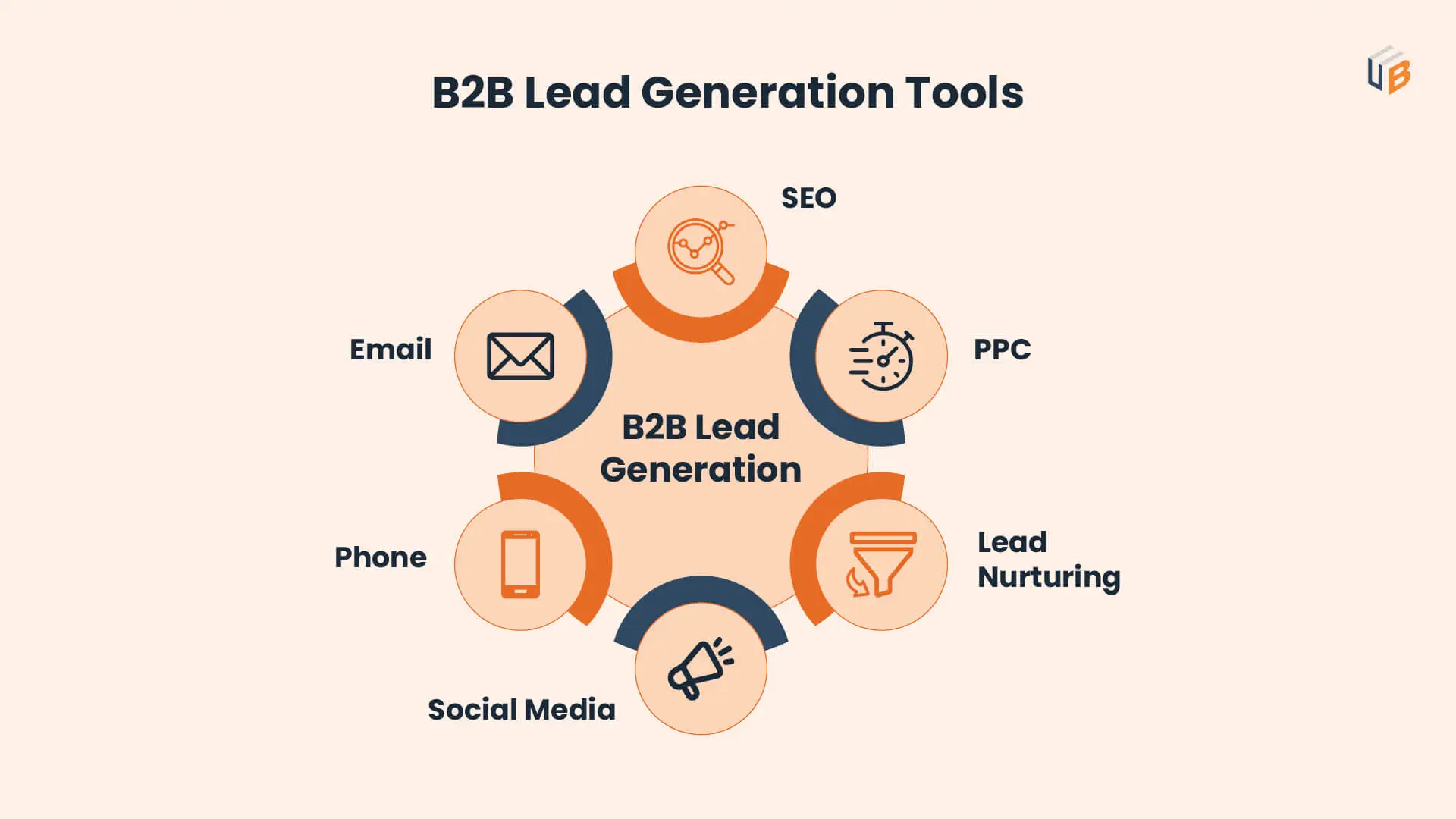
Introduction
An integral part of customer acquisition is lead generation. It is the most important objective of any marketing campaign. You probably heard of lead generations already, and how Entrepreneurs and Marketers are all over it, increasing its potential and customizing it into a perfect fit. But how much do you know about B2B lead generation and its capacity to give an entirely new definition to the concept?
It is okay if you don’t have a full grasp of it now, but certainly, by the end of this article, you’ll be a lot more inclined to generate B2B leads like a pro.
Let’s get started with the definition of a lead.
What Is a Lead?
A lead is one of the prospective customers who show some interest in your product or service. These leads don’t have equal standing, therefore, they don’t get qualified as same. Thus, leads are classified based on their quality and conversion phase. These include:
Top of The Funnel (ToFu):
This stage usually refers to digital strategies that you would employ to bring new traffic and potential leads to your marketing funnel without actually dispiriting or filtering conversations. At this point, your primary focus should be to resolve their question or pain point, and not necessarily tie the purpose with a sale. The most common example would be your blog articles.
-
Marketing Qualified Leads (MQLs):
These are customers who have been reached by your marketing efforts but are not due for a sales call. A visitor that gets attracted to your offer and fills out your landing page form is an example.
Middle of The Funnel Lead (MoFu)
Once the potential leads cross the ToFu stage, they will land at this funnel. It is usually the most difficult stage as the diversity of the interested leads can take any turn. At this point, you should still continue to educate the lead about the solution and also pitch your company as a potential solution provider. Think of advanced eBooks, case studies, videos, white papers, and so on.
-
Product Qualified Lead (PQLs):
They already tried out your services and have come back to pay for more. PQL is commonly found with businesses that offer upgradable trial versions. At this stage, your sales team may take over.
-
Service Qualified Leads:
The interest shown by these prospects in becoming a paid customer comes through your service team. They do this by declaring an interest in service upgrade to your customer support representative, who consequently directs them to the appropriate sales quarters.
Bottom of The Funnel (BoFu):
This is the most crucial stage (also known as the decision stage) as it is at this point that you would be going for the sale. In many industries, this stage may not arrive at all because by this time you would be very comfortable in dealing one-on-one with your customers.
-
Sales Qualified Lead (SQLs):
Your leads will show a greater inclination towards buying your product or service. They will either enquire about your product or even fill up the relevant forms. You could also offer a free trial, assessment, or evaluation of your product or service to start the dialogue and then convert your fully qualified leads to paid customers.
What Is B2B Lead Generation?
B2B lead generation could be attributed to the process of identifying prospective customers (or potential buyers) for your product or service. Sales and marketing teams employ multiple lead-generation tactics to capture the attention of their target buyers and guide potential customers into the sales process.
The key elements of B2B lead generation include:
- Find companies that would benefit from the product or service you sell.
- Attracting prospective customers through different marketing campaigns.
- Identifying the relevant decision-makers.
- Screening prospects based on to what extent they match the buyer profile or express interest in your offers.

How Does Lead Generation Work?
Depending on what you prefer, you could do it yourself or outsource it to a lead generation partner. The process requires you to have a clear picture of the kind of customers you want.
Find out which market types are the most populated. Reach out to such markets and offer them something in return for customer identities like phone numbers and emails. This can later be used to perform an email campaign.
Depending on the quality of leads you can generate and the degree of their inclination towards your business or service you will start seeing results of this exercise in a census of new customers you start receiving.
Doing lead generation yourself saves you money, but outsourcing it to the right lead generation partner gives your business the benefit of an expert approach. Also, you get to save time on the leads, and converting them into loyal customers becomes a lot easy.
Why Do You Need A Lead Generation Process?
A lead generation process gets you a nudge closer to the preferred class of customers who will buy your service and products as needed. This doesn’t mean without lead generation you can’t make the anticipated sales. However, with a lead generation process in place, you have higher chances of getting your target customers in less time.
Further, lead generation:
- Lays the foundation for long-lasting relationships and loyalty with a customer, by using up-to-date tools in analyzing a customer’s purchase pattern and consequently leading them to you.
- Allows easy overhauling of your customer acquisition plan, based on how responsive it is or otherwise.
- Improves your ROI, shrinks your sales cycle to something more palatable, and a larger rate of customer acquisition.
The Mechanics of A B2B Lead Generation
Now you know about the lead generation process and the challenges associated with it, you should be able to start capturing leads and eventually build a subscriber base. But prior to that, let’s determine the mechanics of the process to get it right.
Landing Page
Landing Page is a stand-alone web page and created with a single and focused objective. It is specifically for a digital marketing campaign and it is the first thing a visitor sees upon clicking your link. Types of landing pages include:
- Lead generation landing pages employ the following: a web form as its call-to-action to collect lead data; names and emails and it is most useful for B2B lead generation.
- Click-through Landing pages serve e-commerce firms best with a simple button as its call-to-action.
Lead Capture Forms
Lead capture forms, the primary focus of a lead capture page or landing page, are an absolute must. Without lead capture forms, your business cannot generate leads. The information gathered here becomes useful in personalizing your marketing campaigns. Since people don’t willingly give personal information, it’s important to optimize your forms by:
- Assuring your visitors of privacy
- Requesting for necessary details only
- Avoiding fields that are too distant
Offers
This is something you offer to your prospective customers in return for their personal information. This is a critical element of the lead generation process and it is one of the reasons why customers visit your landing page and will fill out the landing form.
Call-to-Actions
This mechanic drives customers to your offers. It usually comes as a message or a button Image. Keep in mind if your CTA fails to attract your customer’s attention, all lead generation efforts will go in vain.
How Do You Qualify Someone As A Lead?
Qualifying leads is a key step in the sales process to ensure you’re focusing your efforts on prospects who are a good fit and have a genuine interest in your product or service. There are several criteria for determining if someone qualifies as a lead:
The key components you need to identify or remember to qualify someone as a lead:
1. Need – What is the need of the customer that your product/service can solve?
2. Uniqueness – Can your product or solution solve the customer’s need?
3. Budget – Does your customer have the required budget to pay for the product or solution?
4. Timeline – How much time does your customer have to solve the problem?
5. Influence – Is your customer the final decision maker in the buying process?
Not properly qualifying prospects before taking them through the sales process leads to 67% lost sales.
— Steven Tulman, Clover Mortgage Inc.
Lead Generation Methods
In today’s competitive business economy, identifying potential customers and nurturing them into loyal customers is key to success. Lead generation methods provide a strategic structure to achieve this goal. Lead generation methods can be broadly divided into two categories:

Outbound Lead Generation Strategies
- Display Ads – These ads are either targeted towards a specific demography or behavioral action. You can choose where you want to display these ads on a leading publication or a blog where your prospects spend most of their time. Another advantage is you can benefit from re-targeter ads. Once your leads accept cookie settings, your ads will be displayed on the sites that he or she visit later.
- Content Syndication – It is a fact that your prospects may not always land up on your website to start their buyer journey. Content syndication or content sharing strategy can prove to be a good way to promote your articles, white papers, blog posts and press releases, and more on other forums or websites for greater reach and engagement.
- Direct Mail Advertisements – For those of you think that it is a thing of the past, think again. It is still an effective means of communicating your message. You must understand that your prospective customers are busy. Hence browsing any information on the web and getting the required solution for their needs is too much. Again sending an email and waiting for a response may not be the right way of attracting their attention. Here direct emails always work.
- Event Marketing – Events, irrespective of its size, should be a part of your outbound marketing campaign. Events offer you the scope to establish your brand by clarifying any doubts or queries may have regarding your product or service. It also enables you to network with prospective customers and develop a connection with them.
Inbound Lead Generation Strategies
- Social Media – Whether it is Instagram where you can swipe up to check stories or bio links on Facebook, you can take the help of any social media platform to enable your leads to take definitive action. You can choose to promote your products or services and at the end, you can encourage your visitors to take a definite action through a CTA message.
- Content Marketing And SEO – Trust me when we say this, ‘Content is the king’ and it forms the basis of your inbound marketing strategy.
- Email Marketing – Emails are a key component of any marketing strategy or campaign. This is one lead generation strategy that has really stood the test of time. And marketing automation is one of the biggest email marketing trends that has yielded great results for many B2B companies. Email marketing is one of the few online marketing channels that has stood the test of time. In fact, email is 23 years old this year, and it still trumps the top spot on many B2B marketers’ lists of B2B lead generation strategies.
- Website Optimization – This is where the real magic takes place. This is where you should aim to convert your prospective customers.
How Outbound Lead Generation Can Boost Your Sales Process?
Since the past decade or so, outbound lead generation has always yielded the desired results. Inbound work fine when you want to create an awareness of your products/services, but outbound lead generation strategies serve well for activities that need a precise touch. There are several ways in which an outbound lead generation strategy may work for your business:
- Gain From Richer Lead Profiles: Outbound lead generation channels help by gathering as much information as you need to convert your prospects to real customers.
- Share Relevant Content With Your Target Audience: Outbound lead generation strategies do not indicate beating around the bush. Using these strategies, you can present relevant content to the right target audience exactly when they need it. Since today’s leads always look for specific information that does not overwhelm them, outbound marketing works best.
- Streamline Your Sales Funnel: Since sales cycles are often complicated, targeted one-on-one touches solve the purpose by being able to convert leads quicker than ever.
How To Build An Effective Action Plan For Lead Generation
- Determine Your Goals: This requires an initial envisioning of the effects of the B2B plan you are about to establish, you will need a clear process of achieving this vision, and bullet them out as objectives if possible. Determine the quality as well as quantity of leads you want to generate and ensure they align to your business objectives.
- Refine The Customer Profile: At this stage, you need to refine the target companies you want to reach out. You also need to develop the buyer personas that represent the key decision-makers.
- Drive Interest And Awareness: Here awareness comes before interest. Awareness is a process of drawing the attention of your target customers, which can be done in different ways. Interest, on the other hand, is moving the initially established awareness to the next phase, where your customer becomes a lot more inclined to interact with you.
- Gather Information About Your Prospects: Once the leads express interest, you will need to gather as much information about them as possible. This mostly involves contact details, firmographics, demographics, and other necessary details.
- Engage With Your Leads And Nurture Them: Not every lead will turn into a customer. You will need to further engage and nurture a few leads to ensure they are the right fit for your product.
- Test And Track Your Channels And Tweak Them Accordingly: The process just doesn’t end with converting a lead to sales. Testing is another aspect.
The B2B Lead Management Process
Now that you understand how to build an effective lead generation plan, let us walk through the B2B lead management process:
Revisit Your Buyer Persona Profile or Ideal Customer Profile (ICP)
When working on your lead management plan, the first thing you need to do is to revisit your ICP and make sure it is specific to your goal and offers. Your ICP is critical to your success as it will not only focus your resources and efforts on high-quality leads, but also help you meet your sales goals more consistently, extend your Average Customer Lifetime (ACL), and get you more referrals.
Recognize The Data Collection Signals
Throughout the lead generation process, your prospective customers send out signals or clues that indicate how close they are to becoming your valued customers. As a marketer, you should be able to identify these signals. Once you recognize a signal:
- Add the intent data to your data collection plan.
- Create a process to handle all the data assets you have accumulated during the campaign.
- Get a bigger picture by correlating intent data with the fit.
Modify Your Lead Scoring Model
You need to take the following into account while enriching your lead-scoring model:
- Automate the lead scoring process.
- Integrate all the marketing data sources.
- Find a reasonable scoring threshold by comparing the won/lost deals with prospect data.
- Make the criteria more manageable by aggregating intent data and related fit.
- Start with predictive lead scoring if you are dealing with large volumes of data.
Map Your Lead Nurturing Content To Each Stage In The Sales Cycle
The top-class lead nurturing campaigns start with the content mapping process but to nail it, you got to have a psychic ability. To effectively perform this action, you need to understand the purchasing/buying cycle, how content mapping works, and how to apply content mapping to a real-life scenario.
Create A Well-Defined Lead Handoff Process:
It is at this stage that a qualified lead is transferred from the marketing team to the sales team. A well-defined and effective lead handoff process guarantees a successful outcome. To do this ensure:
- Your Marketing and Sales teams understand the common goals and what they expect from each other.
- Define the common criteria for each stage of the lead.
- Set a scoring threshold that is mutually agreed upon by the Marketing and Sales teams.
- Establish notification and follow-up protocols.
- Define a lead handback process for the Marketing team.
Best Practices For B2B Lead Generation
Generating qualified leads is key for B2B businesses. However, with so many marketing channels and strategies available, it can be challenging to know where to begin. Here, we’ll explore some proven best practices to ensure your lead generation campaign reaches the desired objectives:
- Define Your Target Audience – Recent studies show that 76% of consumers love buying from businesses that personalize their marketing efforts.
- Integrate A Live Chat Feature In Your Website – According to a recent study by Forrester, 42% of virtual customers consider live chat to be the most significant feature that a website must have. Everyone expects a quick resolution to their problems.
- Nurture Your CRM Software – Capterra claims that 83% of high-performing companies invest in a CRM tool and the same applies to you if your objective is to drive sales and increase productivity.
- Include A Contact Number On Your Landing Page/Website – Yes, as insignificant it may sound, including a contact number on your web page enhances your credibility.
- Include Testimonials or Media Files For Better Credibility – It is a known fact that testimonials are a nice way to increase the trust of your prospective customers. And if they are in a video format or even pictures, then the chances of increasing your conversion rate are high.
- Use Contests/Affiliates To Promote Your Brand – Don’t you feel food when the grocery store near you runs a contest and you stand a chance to win something by participating in it? Then why can’t you apply the same to your website? Get your audience to write a slogan for your next campaign or maybe come up with some tagline or participate in a quiz and in return offer them something valuable.
- Offer Freebies To Your Visitors – Everyone loves a freebie and your website visitors are no different. A monthly or even weekly newsletter (if that looks like an achievable task) or an eBook can be a great way to lure visitors to share their information and subscribe to your mailing list.
- Encourage Your Customers To Share Online Reviews – 81% of respondents, according to Bright Local, confirmed that they check online reviews before making a purchase. Request your existing customers to share their experience online and if possible, offer them a discount on their next purchase as a return favor.
- Stay Active On User Communities Like Quora – More than 400 million people post their questions on Quora every month. You can make use of this indirect opportunity to market your company by answering their queries.
- Include Forms On Every Page – The best way to persuade a prospective customer to share their information is by placing a form on every page. Just requesting the First Name and email ID will suffice.
Top B2B Lead Generation Tools 2024
This guide would be incomplete, if we do not talk about the important tools that you can use to generate leads. Take a look at the topmost tools that are a favorite with the marketers:

- Email – A great email marketing tool can not only help you automate your email campaigns but also allow you to personalize as well as segment and manage your email campaigns. A few popular tools that are you should definitely check out are MailChimp, Aweber, Pardot, GetResponse, InfusionSoft, and Pardot.
- Phone – Phone-based lead generation tools are fast-trending among lead generation service providers. A phone conversation can be easily used to reinforce connections and responses that you already established through other channels. Some of the popular tools include Bria, Talkdesk, Aircall, Pipedrive, and ExecVision.
- Social Media – By now you are already aware that more than three-fourths of B2B buyers take the help of social media to research purchase decisions and evaluate them. There are a few tools that can help you manage your social media activities effectively including scheduling, analytics, engagement, collaboration, and security. Check out the following tools to achieve your social media marketing tools: BuzzSumo, Oktopost, Buffer, SnapApp, and Brand24.
- SEO – This part of your lead generation campaign should be supported by the best-of-breed SEO tools. The most ideal SEO tools will have the capacity to research, audit, monitor, and rank your campaigns. Further, it also helps in boosting traffic, conversion of leads, and opportunities. The most popular SEO tools are Google Analytics & Google Search Console, Sumo, Screaming Frog, Crazy Egg, and Page Speed Insights.
- PPC – This tool particularly works well for offers that have extended sales cycles, gates content, trial periods, and recurring online touches. Popular PPC tools include WordTracker, Wordstream, RollWorks, Unbounce, and AdWords Performance Grader.
- Lead Management And Lead Nurturing – The above mentioned tools can help you with your lead generation campaigns but to stay on top of the game you further need to manage and nurture your leads time and again. A good lead management and nurturing tool can help you achieve this objective. Top lead management/nurturing tools include Salesforce Essentials, Oracle Eloqua, HubSpot CRM, and Marketo.
Lead Generation Metrics
Now to track your lead generation campaigns, you need to be aware of the metrics. Let’s have a look at some of the common lead generation metrics:
- Performance Metrics – This metric will help you determine whether a particular offer, ad or landing page is performing as per your expectations. Some of the common performance metrics are Click-through Rate (CTR), Conversion rate, Time to conversion, and Return on Investment (ROI).
- Cost Metrics – This metric explains the cost that you incur to acquire new leads and traffic. Under this metric you should track Cost per click (CPC), Cost per mille (CPM), and Cost per lead.
- Channel Metrics – This metric determines how well your channel is performing. Common tracking points for this metric include Lead generation rate by channel and Month-to-date channel goals.
What Are The Lead Generation Mistakes And How to Avoid Them
No matter how much time you invest in your lead generation campaigns, a small mistake can cause big trouble. By no means, I mean to scare you here. But it is better to be safe, than sorry.
According to the Director of Marketing, CloudChekr, Connie Benson, “Content that doesn’t resonate with target audiences is the biggest mistake. Placing content intended for conversion in people’s paths in the social channels is a waste of time and resources.” Hence, you should always create content that is not only interesting and informative but also engages with the target audience. To do this effectively, you need to perform thorough research on your target audience and gain the necessary insight into their lives to know how your solution would resolve their problems.
Technology blogger, Ian Cleary believes, “The biggest lead generation mistake is not building email subscribers.” Ian further claims that not segmenting your email subscribers based on the offers that converted them to leads could have a massive impact on your lead generation campaign. Hence, it is important for your marketing automation software to be capable enough to segment leads based on different parameters, such as industry, demographics, buying behavior, age, and so on.
Heidi Cohen, President of Riverside Marketing Strategies, claims, “Lead generation is skipping the romance portion of the buying process.” She pointed out the areas where marketers can go wrong. More often than not, marketers do not:
- Understand the target audience
- Drive leads
- Incorporate a relevant CTA to enable their prospects to share their contact info
- Have a relevant strategy in place to convert leads into sales
- Track results
Mike Delgado of Experian-North America, indicates, “Figure out all the reasons why a campaign didn’t perform like you wanted and test again later. Test strategically – and don’t be afraid of failure.” He claims it is really important to test the lead generation offer page, the offers, and even the overall design of the campaign. Only when you test and gather hard data, you will know what catches users’ attention and what works for them.
How Will You Calculate ROI On Your Lead Generation Program?
Rеturn on Invеstmеnt (ROI) is a fundamеntal mеtric for mеasuring thе еffеctivеnеss of your lеad gеnеration еfforts. It tеlls you how much rеvеnuе you gеnеratе for еvеry dollar spеnt on acquiring lеads. By tracking ROI, you can identify successful campaigns, optimizе your strategies, and maximizе your marketing budget.
Steps To Calculate ROI For Lead Generation Campaigns
Track Lead Generation Costs: This includes all expenses associated with generating leads, such as:
- Marketing Campaign Costs: Pay-per-click (PPC) ads, social media marketing, content creation, marketing automation tools, etc.
- Sales Team Efforts: Salaries, commissions, and other resources dedicated to lead nurturing and conversion.
- Technology Costs: CRM software, lead capture forms, landing page development, etc.
Calculate Sales Revenue Generated From Leads: Track the revenue generated from leads converted into paying customers. This might involve:
- Sales Pipeline Tracking: Monitor how many leads convert into opportunities, quotes, and finally, closed deals.
- Customer Relationship Management (CRM) Data: Utilize your CRM to attribute sales back to the original lead source.
Calculate ROI: Once you have your costs and revenue figures, use the following formula to determine your ROI:
ROI = (Revenue – Cost) / Cost x 100%
Conclusion
To sum up, it would not be an overstatement that any marketing strategy could be effectively measured by the volume and more importantly, the quality of leads they drive in. Despite the abundance of data available online on how to generate leads, most marketers still struggle to generate high-quality leads and lose out on their marketing campaigns. This is where you would find this guide useful.
This guide has the relevant information you need to understand along with many other resources to get a better understanding of the lead generation market and how to generate high-quality B2B leads. Follow the techniques suggested in this guide to effectively market your business and build a reputable market share. Also, you should be able to penetrate into newer markets and build leads that have high conversion rates.
Our blog
Latest blog posts
Tool and strategies modern teams need to help their companies grow.

In the absence of a solid lead scoring system, your sales team will spend time pursui...

Programmatic ABM combines the effectiveness of targeted engagement with automation. I...

Take advantage of the year-end holiday rush so you can boost your SaaS revenue and st...





